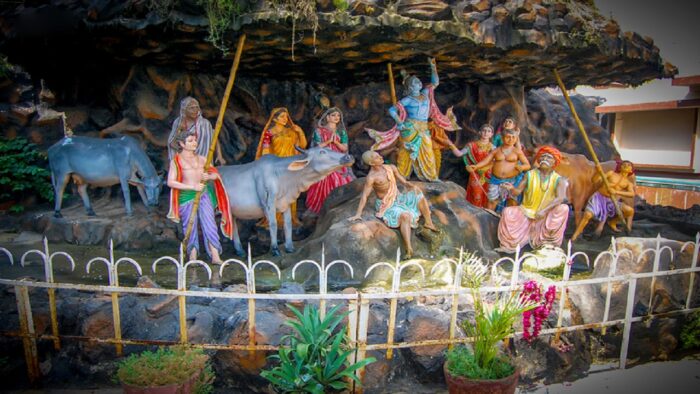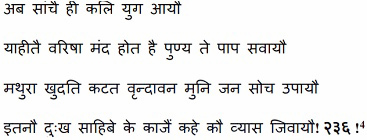Abstract
The development of the region of Braj during the medieval period brought the region’s natural environment in dialogue with the Bhakti sects. Braj region’s natural environment was seen as an embodiment of the divine in this reconstruing of the region. Narayan Bhatt, a sixteenth- century devotee of Gaudiya sect, put forward the idea of Braj being the body of Krishna and each and every tree, stone and river as an extension of his past times, thus placing the sacred’s manifestation in the natural environment. The groves, plants, rivers, food, raj (Braj sand), all sacred ‘hierophanies’1 made the natural environment of the region an experience of the divine.
The construction of the built environment in the form of temples, ghats etc. all brought changes to the natural environment. This brings us to a point where there is a need to explore the development ensued by the Goswamis and see if it is in harmony with the natural environment? How were the Goswamis able to deal with this dichotomy of establishing the temples and yet maintain the original idea of what Puranic Vraja was? What do the sources point toward?
The hagiographies and sectarian literature of Braj bhasha archives are replete with loving devotion and protection awarded to the animals and birds of the region. Mughal Imperial orders banning the killings of peacocks and cows and granting grazing rights in vicinity of their favored hunting grounds reflect the strategic importance of a sacred space located so close to the Mughal capitals. The farmans are in accordance with the preservation of nature, embedded in the working of the sects present in Braj during the medieval period.
‘’Geography of religion is the study of the part played by a religious motive in man’s transformation of the landscape. It presumes the existence of a religious impulse in man which leads him to act upon his environment in a manner which responds secondarily, if at all, to any other need.’’2
Ideally, if the Goswamis were looking for the Vraja as mentioned in the earlier Puranas, then it was practically impossible to have located it at one place due to its mobile character, however, one feature that was common with the early representations of Vraja and its later transformations, was it being surrounded by the forest cover, presence of a mountain (Govardhan) and proximity to Yamuna. Hence, the surrounding environment assumes central importance.
The architectural development in the region places the built environment of Braj in a dichotomous position as to how sacred which is already manifested in the natural environment, needs a built environment for its external expression. This brings us to a point where there is a need to explore the development ensued by the Goswamis and see if it is in harmony with the natural environment? Or did it lead to the degradation of the environment as it led to urbanisation and deforestation? How were the Goswamis able to deal with this dichotomy of establishing the temples and yet maintain the authentic idea of what Puranic Vraja was? What do the sources point toward?
This dichotomy has been addressed to some extent by scholars like Sugata Ray who explores the connection between the divine body and the land of Braj with all its stones and dust. When these materials associated with the land are used for artistic purposes or for architectural construction, they are seen as an extension of the natural environment. He argues that at ‘mineralogical level’, the sandstone with which Govindadeva temple at Vrindavan was made from, was the same which formed the Govardhana Ridge thus the architectural construction of Braj was in alignment with the natural.3 The natural environment then can be experienced even with the built environment of Braj.
We find a record of this consciousness and dichotomy of establishing settlements and cutting of trees in contemporary accounts as well. Hariram Vyas, a poet of 16th century writes that he feels very disheartened by watching the condition of the environmental degradation of the sacred Braj. He says:
(This is the true beginning of the Kaliyuga age
The rains have declined as the sins have surpassed virtuous deeds Mathura is dugged up and Vrindavan is being deforested
Oh revered ones please look for a solution
Why has God kept me alive? To witness this havoc!!)
Vyas, who was a poet from the adjoining state of Orchha and had settled down in Vrindavan, is writing in the context of expansion of settlement patterns and construction activities taking place particularly in Vrindavan. He is lamenting this change as for him, it seems the idea of Braj was much beyond its built environment.
To bring this development in harmony with the natural environment, the architectural construction of temples of Braj came to incorporate Baghs attached to temple premises and even Kundas. There was a Bagh (garden) attached to almost every temple structure in Braj, there are documents ordering against the cutting or selling of these gardens by the authorities.5 Krishandas, a successor of Jiv Goswami, while transferring his property, which he had received from Jiv Goswami, mentions one garden and dwelling located at Radhakund as his property.6 Another such sale deed informs us about selling a garden and even some trees apart from the garden to one Gosain Govindji for rupees 150.7
It seems that as the documents suggest the mention of Baghs still being attached to the institution of the temple as late as the 18th century, the religious men of Braj tried to keep the idea of Braj intact in some or the other form. They tried to keep pace with the changing landscape of Braj on one hand and also persevered to preserve the originality at the core of the idea of the region. As discussed in great detail by Sugatha Ray, with the beginning of the 18th century we see the idea of Kunjas becoming central to many temples in Braj.
The Puranas also lay emphasis on the spiritual elements embedded in the trees and flora of Braj. As mentioned:
(Every tree is the embodiment of the Flute bearer (Krishna) and each leaf represents his Chaturbhuj form)
The trees, creepers are seen as alive in the scriptures. Besides, it seems that even the trees where the leaders of a particular sect had a seat (nishatgah), were seen as the property of the respective sects and were often reclaimed in cases it was usurped.8
The Braj’s natural environment has also seen as stimulator of varying emotions -in devotees as well as poets- one of them being ‘uddipana vibhava’ that is ‘mood- enhancing scenery’ in context of aesthetics.9 Braj poets speak at length about their bhavas (emotions) about the natural landscape of Braj.
There is a very significant document in the form of a pledge wherein the headmen of the village of Radhakunda are pledging to not to cut any trees or even tree branches above Radhakund and not to till any land near the retreats (kunjas) of two particular gosains.10 This can be certified by the fact that the Gardens of Radha Kund were even being bought by the Govind Dev temple in the 18th century as well. One such garden named as Bagh-i- Ghasi Ram comprising 5400 sq. yards was sold for 205 rupiya in favour of Gosain Jagannath, Adhikari of Govind Rai temple.11
Such incidents also find mention in the regional sources as well, in one such Varta, one Ali Khan Pathan,12 a headman of one village of Braj, punishes everyone who would want to even take a leave from the trees of his village and takes stringent actions to save the ‘revered’ trees and environment of Braj.13
Haridasis preserved the idea of bowers and forests as this sect established their deity in a bower and did not make a large temple structure like their Pushtimarg and Gaudiya counterparts. The primary and only deity of the sect was established in Nidhi Vana, located in Vrindavan and was not moved to a temple till late 18th century. For the sects following Nikunj Prampara, i.e. the tradition of groves and bowers where the divine couple indulges in playful activities, it is the bower which is the true sacred space and temple structure is just an addition but not central to this space. The Phool bangla (i.e. Palace of Flowers) art still aims at recreating the environmental surrounding which is at the core of the idea of Braj.
Not only does the Braj flora but even the fauna of Braj received protection by people and even the Imperial government at the time. As mentioned in the introduction of the thesis, the jungles around Mathura were the favorite of Mughals for hunting. However, we get evidence of Imperial orders, ordering the jagirdars of pargana Mathura, Mangotah, Od and Sahar to impose a ban on peacock hunting in the neighbourhood of these parganas.14
This farman is in accordance with the preservation of animals and birds embedded in the working of the sects present in Braj. We get to know about Swami Haridas, the head of the Haridasi sect, tending and nurturing animals, birds and marine life alike.15 Even giving parsada to the animals thus treating the fauna of Braj as an extension of the divine. That the Peacocks were revered in Braj bhumi is also attested by the presence of Mor Kutir in Barsana, a temple named ‘House of Peacocks’ where the peacocks are protected and even worshipped. 16
The orders for the protection of fauna of Braj continued well into the British period. However, we do see a conflict between the British Government and the people of Braj over the protection of animals and the environment.
We also see a conscious attempt to save the sacred water bodies from getting polluted by the people and Goswamis taking measures to prevent it. When Raghunathdas would see that the people wanted to clean their clothes in the holy waters of Radha Kund and Krishna Kund, to dissuade them and to bring a viable solution, he led to the digging of wells near the Kundas. 17
References
1 Mircea Eliade , ‘ The Sacred and the Profane’ , The Nature of the Religion. Translated by William R. Trask., USA: Harcourt, Inc. 1957.
2 Gregory J. Levine, Transactions of the Institute of British Geographers , 1986, Vol. 11, No. 4 (1986), pp. 428- 440.
3 Sugatha Ray, Climate Change , pp. 88-90.
4 Hariram Vyas, Vyas Vani, Chhand 236, p. 89.
5 Many Baghs of the temples of Braj have survived and one can visit them with permission. One such Garden known as Bada Bagicha is attached to the Rangnathji’s temple located in Vrindavan.
6Tarapada Mukherjee and J.C Wright , A testamentary , P. 316.
7 NAI 2697/3, Dated 1745 A.D. See R.K Perti , Descriptive list , p. 129.
8 See, Gauranga Bengali, 1654 , p. 138.
9 Williams, Richard David. A theology of feeling: the Radhavallabhi monsoon in the eighteenth century, in Monsoon feelings : a history of emotions in the rain edited by Imke Rajamani, Margrit Pernau and Katherine Butler Schofield. New Delhi, India : Niyogi Books, 2018.Pp. 84-5.
10 See A Documentary History, Document of Braj Kunwar Gosain , pp. 136-7.
11 NAI, 2691/11, Dated: 1722-23 A.D. See R.K Perti, Descriptive list, p. 95.
12 It seems that this can be the same Ali khan Pathan as mentioned in one of the sale deeds mentioned earlier.
13 252 Vaishnavan ki Varta , P. 291-294.
14 Krishan Lal Jhaveri, Imperial Farmans , Document NO. IVA. ; See Irfan Habib, Akbar and the temples …, p. 238.
15 गानकला गन्धर्व श्याम स्यामा को तोषैं
उत्तम भोग लगाए मोर मरकट ततलम पोषें. Nabhadas, Bhaktamal, Chappay 89, p. 514. Swami was a singer par excellence that he even put Gandharvas to shame, He would serve Bhog to the God and nurture Peacocks, Monkeys and Fishes.
16 VDA, P. 18 , Pad 28;
17 Steven Rosen, Six Goswamis , pp. 57-58.
Feature Image Credits: dreamstime.com
Watch video presentation of the above paper here:
Disclaimer: The opinions expressed in this article belong to the author. Indic Today is neither responsible nor liable for the accuracy, completeness, suitability, or validity of any information in the article.









